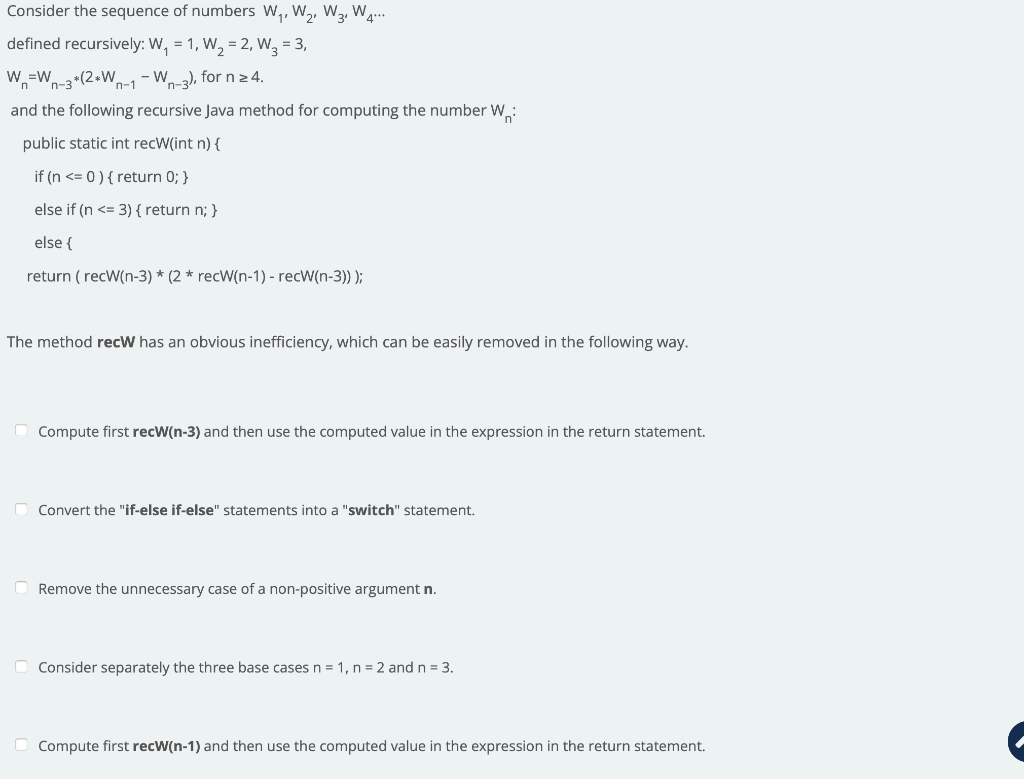Consider the sequence of numbers W,, W,, W3, Wg... defined recursively: W, = 1, W, = 2, W3 = 3, W_=W3+(2•W-1 -Wa), for n2 4. Vn-3), for n 2 4. and the following recursive Java method for computing the number W,: public static int recW(int n) { if (n <= 0 ) { return 0; } else if (n <= 3) { return n; } else { return ( recW(n-3) * (2 * recW(n-1) - recW(n-3)) ); The method recW has an obvious inefficiency, which can be easily removed in the following way.
Consider the sequence of numbers W,, W,, W3, Wg... defined recursively: W, = 1, W, = 2, W3 = 3, W_=W3+(2•W-1 -Wa), for n2 4. Vn-3), for n 2 4. and the following recursive Java method for computing the number W,: public static int recW(int n) { if (n <= 0 ) { return 0; } else if (n <= 3) { return n; } else { return ( recW(n-3) * (2 * recW(n-1) - recW(n-3)) ); The method recW has an obvious inefficiency, which can be easily removed in the following way.
Computer Networking: A Top-Down Approach (7th Edition)
7th Edition
ISBN:9780133594140
Author:James Kurose, Keith Ross
Publisher:James Kurose, Keith Ross
Chapter1: Computer Networks And The Internet
Section: Chapter Questions
Problem R1RQ: What is the difference between a host and an end system? List several different types of end...
Related questions
Question

Transcribed Image Text:Consider the sequence of numbers W,, W,, W2, W.
defined recursively: W, = 1, W, = 2, W3 = 3,
W,=W-3 *(2+Wn-1- W-a), for n 2 4.
and the following recursive Java method for computing the number W.:
public static int recW(int n) {
if (n <= 0 ) { return 0; }
else if (n <= 3) { return n; }
else {
return ( recW(n-3) * (2 * recW(n-1) - recW(n-3)) );
The method recW has an obvious inefficiency, which can be easily removed in the following way.
O Compute first recW(n-3) and then use the computed value in the expression in the return statement.
Convert the "if-else if-else" statements into a "switch" statement.
Remove the unnecessary case of a non-positive argument n.
O Consider separately the three base cases n = 1, n = 2 and n = 3.
O Compute first recW(n-1) and then use the computed value in the expression in the return statement.
Expert Solution
This question has been solved!
Explore an expertly crafted, step-by-step solution for a thorough understanding of key concepts.
Step by step
Solved in 2 steps with 1 images

Recommended textbooks for you

Computer Networking: A Top-Down Approach (7th Edi…
Computer Engineering
ISBN:
9780133594140
Author:
James Kurose, Keith Ross
Publisher:
PEARSON

Computer Organization and Design MIPS Edition, Fi…
Computer Engineering
ISBN:
9780124077263
Author:
David A. Patterson, John L. Hennessy
Publisher:
Elsevier Science

Network+ Guide to Networks (MindTap Course List)
Computer Engineering
ISBN:
9781337569330
Author:
Jill West, Tamara Dean, Jean Andrews
Publisher:
Cengage Learning

Computer Networking: A Top-Down Approach (7th Edi…
Computer Engineering
ISBN:
9780133594140
Author:
James Kurose, Keith Ross
Publisher:
PEARSON

Computer Organization and Design MIPS Edition, Fi…
Computer Engineering
ISBN:
9780124077263
Author:
David A. Patterson, John L. Hennessy
Publisher:
Elsevier Science

Network+ Guide to Networks (MindTap Course List)
Computer Engineering
ISBN:
9781337569330
Author:
Jill West, Tamara Dean, Jean Andrews
Publisher:
Cengage Learning

Concepts of Database Management
Computer Engineering
ISBN:
9781337093422
Author:
Joy L. Starks, Philip J. Pratt, Mary Z. Last
Publisher:
Cengage Learning

Prelude to Programming
Computer Engineering
ISBN:
9780133750423
Author:
VENIT, Stewart
Publisher:
Pearson Education

Sc Business Data Communications and Networking, T…
Computer Engineering
ISBN:
9781119368830
Author:
FITZGERALD
Publisher:
WILEY